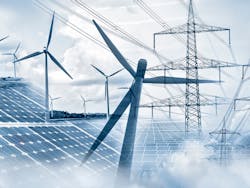California PUC Orders Clean Energy Procurement, Launches DER Rulemaking
California continues blazing a trail in the US energy transition under two decisions last week, one that requires utilities to buy 11,500 MW of emissions-free power supply and a second that launches a new regulatory proceeding focused on preparing the grid for proliferating distributed energy resources (DERs), including electric vehicles.
More than 20,000 MW expected
Under the June 24 procurement decision by the California Public Utilities Commission (CPUC), load-serving entities (LSE) must contract for 2,000 MW of emissions-free net qualifying capacity (NQC) by 2023, an additional 6,000 MW by 2024, another 1,500 MW by 2025 and 2,000 MW by 2026.
NQC is a measure of how much capacity a certain resource will likely deliver during peak demand periods. Intermittent resources like wind and solar have NQCs of 15% and 14%, respectively.
As a result, California’s utilities and LSEs will likely need to add more than 20,000 MW of nameplate renewables and battery storage to meet the PUC’s requirements, according to Mohit Chhabra, a scientist with the Natural Resources Defense Council.
Chhabra expects that most of the power procurement will come from a combination of wind and solar coupled with battery storage, demand response and geothermal energy.
The power procurements are designed to help replace once-through-cooling coastal power plants totaling 3,700 MW and Pacific Gas & Electric’s 2,250-MW Diablo Canyon nuclear power plant.
In its decision, the PUC dropped a recommendation from an administrative law judge that some of the new power supplies come from natural gas-fired power plants. The PUC will consider allowing utilities to contract for fossil-fuel generation in upcoming procurements after the agency gets more information on whether gas-fired plants are needed to maintain a reliable grid.
The procurements in 2026 must include 1,000 MW of “long-duration” energy storage that can produce at least eight hours of electricity.
In the same year, another 1,000 MW must be from long-lead time renewables such as geothermal with an 80% capacity factor at least.
Join us for Microgrid California, an educational forum in the San Francisco Bay Area hosted by Microgrid Knowledge on Oct. 5, 2021
The procurement decision is designed to help California meet its 40% greenhouse gas emissions reduction target for 2030 and to keep the state on a path to meeting its goal of 100% zero-carbon electricity by 2045, the PUC said.
PUC launches rulemaking on DERs
Meanwhile, the PUC launched a new rulemaking focused on preparing the grid for more DERs, with a possible impact on microgrids.
The rulemaking will also take up unresolved issues from the PUC’s distribution resources plans (DRP) and integrated distributed energy resources proceedings, which are ending this year.
“The expected proliferation of distributed energy resources in California, led by millions of new electric vehicles, will pose new challenges for distribution planning and load management as well as new opportunities for making customer demand more flexible, integrating renewable generation, increasing customer resiliency and promoting equity,” PUC Commissioner Darcie Houck said.
The PUC said the rulemaking’s goals include:
—Enabling the rapid evolution of grid capabilities and operations to integrate solar, storage, electric vehicles and charging equipment, flexible load management and other distributed energy resources
—Improving distribution planning, including for charging infrastructure to support cost effective and widespread transportation electrification
—Optimizing grid infrastructure investments by facilitating community input about planned developments, distributed energy resources siting plans and resiliency needs
The rulemaking is being divided into three tracks: high-level policy issues involving distribution system operator roles and responsibilities as well as investor-owned utility and aggregator business models; the near-term evolution and improvement of the adopted DRP frameworks, analytic tools and planning processes; and near- and medium-term grid modernization investments, using smart inverters to leverage advanced functionality to provide grid services, and aligning rate cases with planned infrastructure investment.
Generally, microgrid and resiliency issues will be addressed in a separate ongoing microgrid proceeding (R.19-09-009), according to the PUC.
Track news about California energy policy. Subscribe to the free Microgrid Knowledge Newsletter.
